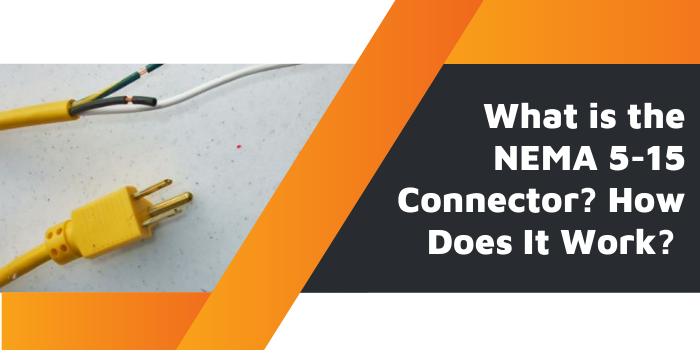What is the NEMA 5-15 Connector? How Does It Work?
Electrical appliances are among some of the most popular consumer products worldwide. Everyone needs electrical devices from refrigerators to air conditioners, be it for work or convenience at home.
However, powering these devices can get tricky if you don’t know the suitable connectors and plugs to use. It’s even more frustrating if you travel abroad and realize all your plugs are incompatible with the sockets. Hence, understanding the electrical standards and connectors, both home and abroad, can help keep your devices safe and prevent electrical hazards.
People looking to work around electrical appliances in the US often ask what a NEMA 5-15 connector is. If you’ve found yourself wondering what these connectors are and how they work, look no further. This article addresses these questions and clarifies some of the most confusing aspects of the NEMA standard.

What is a Nema 5-15 Connector?
Before you can understand the connector and its purpose, you have to know NEMA’s meaning. It simply means the National Electrical Manufacturers Association. This is the body that regulates the electrical standards in North America.
They aim to ensure safety and consistency among electrical manufactures and users. Hence, a system standardizes the rating and description of sockets and plugs used in the country.
Therefore, the NEMA connector is a system that enables electrical devices to connect to power supplies. These systems can either convey direct current (DC) or alternating current (AC). However, alternating current is the standard current flowing through the electrical systems of most homes, buildings, offices, and stores. An excellent example of direct current is power derived from batteries.
Despite the popularity of the two or three-prong plugs in the US, several other types of connectors are used worldwide. These vary in the amperage and voltage they use. But electrical supplies, devices, and their manufacturers conform to the NEMA standards. Thus, determining the specific positions and sizes of the prongs of plugs and their respective receptacles.
But to meet the varying power requirements of different electrical appliances, there are other NEMA connectors, and the Nema 5-15 is one of the many.
Types of NEMA Connectors
NEMA connectors are broadly categorized as locking and non-locking. These two are differentiated by the plugs that work with them. Locking connectors have plugs that have curved blades. You turn the plug after inserting it into the connector to lock it in place.
Usually, these types of connectors can be found in industrial and commercial settings. However, you can al so find midget or miniature locking NEMA connectors denoted by “ML.” Hence, the NEMA 5-15 connector can either be locking or non-locking.
Grounded vs. Ungrounded
Apart from the locking system, your NEMA connector can either be grounded or ungrounded. Grounded simply means that extra power goes to the ground away from your appliances. This type of wiring helps avoid power surges leading to electric shock or overload.
Ungrounded plugs have two pins, while grounded ones have three. Mainly, the ground pin is positioned above the two to prevent metal objects from touching the hot line.
How The NEMA 5-15 Connector Works
The NEMA 5-15 works for voltages up to 125 volts. The number “5” indicates the voltage rating and the configuration of the voltage. Supposing you intend to use a US plug at 250 volts, it’s necessary to use a different configuration apart from the regular NEMA 5-15, like the NEMA 6-16.
You can find countries that are yet to standardize their regulations for electricity, such as the Philippines, using NEMA 5-15 at 220VAC. However, this requires a lot of caution. As you’ll learn, the full name of the connector describes the rating of the plug and socket pattern. Consequently, each number and alphabet is significant to how the connector operates.
You can tell the voltage level from the first number:
- “1” signifies a rating of 125 volts, Class II (ungrounded)
- “5” indicates a rating of 125 volts, Class I (grounded)
- “6” denotes a rating of 250 volts, Class I (grounded)
The following number is used to signify the amperage rating. It usually ranges from 15 to 60 amps.
Also, you’ll notice two letters—one in front of the numbers and the other at the end. The one at the end shows whether the cord is a receptacle or plug. Hence, P = plug and R = receptacle.
However, the first letter, usually “L,” indicates the locking configurations. For instance:
- 5-15R means 125V, Class 1, 15A receptacle
- L5-15P means Locking, 125V, Class 1, 15A plug
The same applies if you see “1-60R '' or any of the other configurations that exist for the NEMA standards.
Conclusion
Generally speaking, every electrical connector can enable an electric appliance to plug into a power source. This can either be a direct current or alternating current power outlet since electrical power connectors can carry AC and DC.
However, there are set standards that determine which plugs are compatible with suitable connectors. If you’re traveling to the US from a country that uses a different set of connectors, you’ll need to find plug adapters and devices that use the standard ratings of 15 to 60 amp and voltages ranging from 125 to 600 volts. The same applies when you’re traveling abroad.


